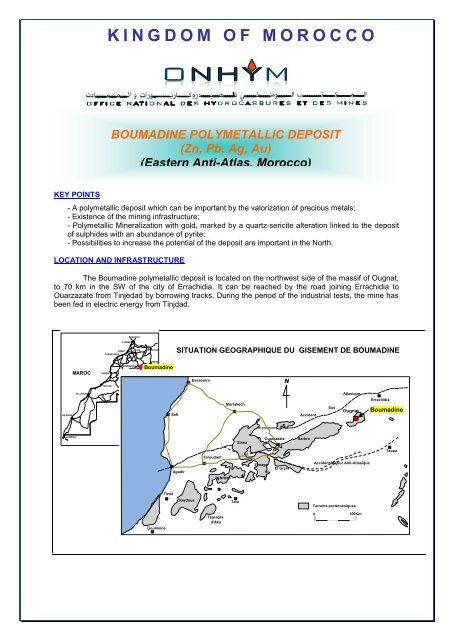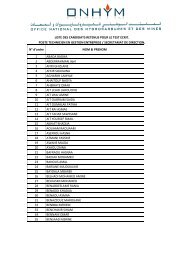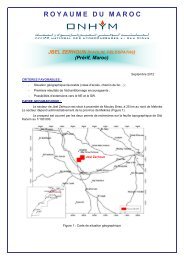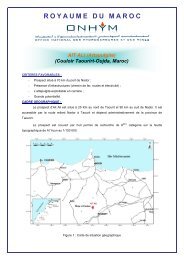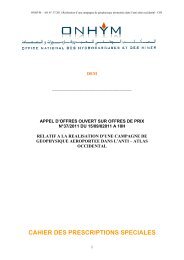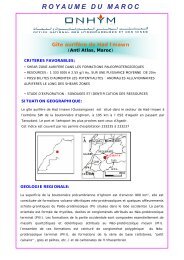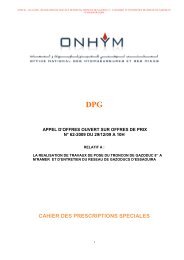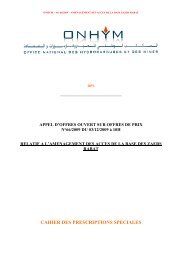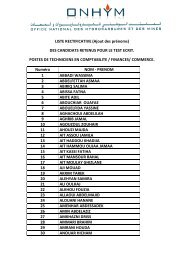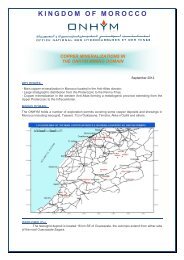K I N G D O M O F M O R O C C O
K I N G D O M O F M O R O C C O
K I N G D O M O F M O R O C C O
Create successful ePaper yourself
Turn your PDF publications into a flip-book with our unique Google optimized e-Paper software.
KEY POINTS<br />
AD DAKHLA<br />
RABAT<br />
CASABLANCA<br />
TANGER<br />
OUARZAZATE<br />
MAROC AGADIR<br />
TAZENAKHT<br />
LAGWIRA<br />
EL AYOUN<br />
K I N G D O M O F M O R O C C O<br />
TAN TAN<br />
BOUMADINE POLYMETALLIC DEPOSIT<br />
(Zn, Pb, Ag, Au)<br />
(Eastern Anti-Atlas, Morocco)<br />
- A polymetallic deposit which can be important by the valorization of precious metals;<br />
- Existence of the mining infrastructure;<br />
- Polymetallic Mineralization with gold, marked by a quartz-sericite alteration linked to the deposit<br />
of sulphides with an abundance of pyrite;<br />
- Possibilities to increase the potential of the deposit are important in the North.<br />
LOCATION AND INFRASTRUCTURE<br />
The Boumadine polymetallic deposit is located on the northwest side of the massif of Ougnat,<br />
to 70 km in the SW of the city of Errachidia. It can be reached by the road joining Errachidia to<br />
Ouarzazate from Tinjedad by borrowing tracks. During the period of the industrial tests, the mine has<br />
been fed in electric energy from Tinjdad.<br />
Espagne<br />
MARRAKECH<br />
Tafrent<br />
FES<br />
OUJDA<br />
FIGUIG<br />
Boumadine<br />
Goulimine<br />
Tiznit<br />
Safi<br />
SITUATION GEOGRAPHIQUE DU GISEMENT DE BOUMADINE<br />
Agadir<br />
Kerdous<br />
Essaouira<br />
Taroudant<br />
Ighrem<br />
Marrakech<br />
Tata<br />
Sirwa<br />
Zenaga<br />
N<br />
Accident<br />
Ouarzazate Sarhro<br />
El Grara<br />
0<br />
Tagragra<br />
d'Aka<br />
Sud<br />
Atlasique<br />
Ougnat<br />
Accident Majeur Anti-Atlasique<br />
Tarrains protérozoiques<br />
100Km<br />
Errachidia<br />
Boumadine<br />
Taouz
Néoprotérozoïque<br />
terminal<br />
REGIONAL GEOLOGY<br />
The massif of Ougnat is constituted of a basement schiste-sqndstone of the upper Neoproterozoic<br />
surmounted by a set of volcano-sedimentary formations of the terminal Neoproterozoic and limited<br />
by a Paleozoic cover. The basement is represented by a succession of sandstone, pelites and<br />
grauwackes. It shows locally intrusions of granite, granodiorite and diorite. The terminal<br />
Neoproterozoic consists of acidic and basic facies separated by volcano-detrital and sedimentary<br />
episodes. II is subdivided in three formations which are from the oldest to the most recent :<br />
- Volcanic formation of Tamerzaga, which includes ignimbrites, rhyodacites and andesites.<br />
This formation contains the mineralization of Boumadine.<br />
- Formation of transition which is volcano-sedimentary, it starts by a level of tuffs, and<br />
continues by deposits of breccias, sandstone, limestones, pelites and conglomerates.<br />
- Volcanic formation of Aoujane Aissa which is essentially formed of ignimbrites and dacite.<br />
These formations are crossed by basic dykes (dolerite, microdiorite and andesite) which are<br />
reduced at the mine to andesite dykes NS to N 170°.<br />
The massif of Ougnat was subjected to a Neoproterozoic shearing, causing regional faults<br />
N30° and associated secondary fractures. It has also been affected by a last stage of extensional<br />
fractures NS before finally being assigned by the hercynian essentially compressive<br />
Several indices and mineralized occurrences have been recognized in the massif of Ougnat.<br />
They can be classified into two types :<br />
� Lead-copper mineralization in quartz-carbonate gangue and barium filling fractures EW<br />
(Hercynian or probably Liassic). This type of mineralization doesn't have a big economic<br />
importance;<br />
� A polymetallic sulphide mineralization PBGC, type Boumadine with concentration of Zn,<br />
Pb, Ag and Au filling fractures NS to N 160° (Neoproterozoic).<br />
The massif also contains other substances such as barite and pyrophyllite.<br />
LEGENDE<br />
Quaternaire<br />
Couverture paléozoïque<br />
Ensemble basique terminal<br />
Formation d'Aoujane Aissa<br />
Formation de transition<br />
Formation de Tamerzaga<br />
Socle (Néoprotérozoïque supérieur)<br />
Granite de Mellab<br />
Rhyolites<br />
Sill basique de Bou Isseghi<br />
Dykes<br />
Piste<br />
Faille<br />
CARTE GEOLOGIQUE SIMPLIFIEE DE L'OUEST DE L'OUGNAT<br />
Ü<br />
0<br />
Vers Isilf<br />
2 Km<br />
NS<br />
N30<br />
NNW<br />
Ç<br />
Mine<br />
Vers Mellab
LOCAL GEOLOGY<br />
The Boumadine deposit is hosted in ignimbrite of the volcanic formation of Tamerzaga<br />
(terminal Neoproterozoic) based, through a level of detrital brechia, on the folded and metamorphosed<br />
basement (upper Neoproterozoic). At the outcrop, the ignimbrite is very heterogeneous and greenish<br />
with feldspath phenocrysts in varying proportions. It has an average depth of 400 m around the mine<br />
and it decreases until it disappears to the north. It should be noted that some intrusions are<br />
contemporaneous to deposit of ignimbrite. This includes trachyandesite sills, chonolites of ryholite,<br />
dykes and andesite.<br />
Three episodes of alteration were distinguished in the sector of Boumadine, a propylitization<br />
affecting formation of Tamerzaga, quartz-sericite alteration around mineralized veins accompanied by<br />
development of chlorite and carbonates and related to sulphide deposition with an abundance of pyrite<br />
and finally an alteration affecting the post-mineralized formations and marked particularly by a<br />
dominant chloritization and reddening.<br />
The tectonic pattern affecting Boumadine deposit is characterized by a large accident N160 °, which<br />
contains the main mineralization, accompanied by crushing zones (oriented NS and NNW-SSE) in<br />
which the veins are hosted. The entire veins are intersected by a hercynian fault system that causes<br />
their fragmentation.<br />
Boumadine mineralization consists of veins extending over 4 km on the surface. It is marked by<br />
discoloration areas (limonite) structures along the subvertical NS and NNW-SSE direction and the<br />
thickness of veins varies from 1 to 4 m. This mineralization is hosted in the ignimbrite as veins with<br />
250 to 350 m of deep. It consists of massive pyrite, sphalerite, galena, arsenopyrite and of many other<br />
minerals in lesser quantity (chalcopyrite, cassiterite, stannite, enargite, gray copper, etc....). Pyrite is<br />
the matrix and forms the central part of the body vein, other sulphides, particularly galena and<br />
sphalerite, are more concentrated in the margins of veins. The Boumadine mineralization is epithermal<br />
whose equivalents are vein deposits of the Andean chain.
RESEARCH WORK<br />
The polymetallic Boumadine deposit has been the subject of several researches since the sixties until 1992 in<br />
order to certify more resources, increasing the potential of the deposit and perform tests industrial pilots.<br />
Geological research campaigns that were conducted on different sectors of the deposit consisted of conducting<br />
geological, topographical, geochemical and geophysical studies to delimitate the mineralized zones. The deposit<br />
was also be the subject of mining works during the period 1964 -1989 which consisted of surveys, wells, galleries,<br />
transcuts etc. The volume of the research work by drilling and mining work performed on the Boumadine deposit<br />
during the period 1964-1992 can be summarized as:<br />
• Drillings : 32756 m<br />
• Gallery : 6036 m<br />
• Wells : 638 m<br />
METALLURGICAL TESTING<br />
Taking into consideration the nature of Boumadine deposit, studies and pilot industrial tests<br />
have succeeded between 1986 and 1992 by SODIM, and BRPM SODECAT which conducted a<br />
differential flotation in order to improve recovery of Precious metals in concentrates galena and<br />
sphalerite. The results of chemical analysis performed on several batches of ore deposit are :<br />
S Fe Sio2 Zn Pb As Cu Cd Sn Ag Au<br />
35% 29% 21% 6% 2% 2% 0,20% 0,10% 0,09% 400 ppm 3,50 ppm<br />
The results of metal tests by flotation differential are :<br />
RESOURCES<br />
galena Concentrate Sphalerite Concentrate Content of releases<br />
Pb (%) 41,55 Zn (%) 44,50 Pb (%) 0,4<br />
Ag (g/t) 4711 Ag (g/t) 565,00 Zn (%) 0,96<br />
Au (g/t) 24,64 Au (g/t) 3,70<br />
Ag (g/t)<br />
Au (g/t)<br />
125<br />
2,38<br />
Galena Metal Recovery (%) Sphalerite Metal Recovery (%)<br />
Pb 69,08 Zn 77,04<br />
Ag 32,01 Ag 18,03<br />
Au 13,52 Au 9,53<br />
The resurces update at end August 1992, the date of the cessation of industrial tests, is 3838<br />
970 t divided into:<br />
- Measured resources : 1043 010 t à 0,77 % Pb - 3,65 % Zn - 186 g/t Ag et 3,66 g/t Au.<br />
- Indicated resources : 869 960 t à 0,65 % Pb-3,12 % Zn -171 g/t Ag et 1,56 g/t Au<br />
- Infered resources : 1926 000 t<br />
PERSPECTIVES<br />
- Ability to discover additional similar mineralization;<br />
- Possible development of the mineralization at depth on the NW;<br />
- Geophysical methods (electromagnetic and induced polarization) are well removed their<br />
effectiveness in identifying mineralized structures.<br />
For further information, please contact:<br />
Mme Amina BENKHADRA<br />
General Director<br />
5, Avenue Moulay Hassan- BP 99 - Rabat, Morocco<br />
Tel. : + 212 37 23 98 98 – Fax : + 212 37 70 94 11<br />
E-mail : benkhadra@onhym.com<br />
Site web : www.onhym.com


